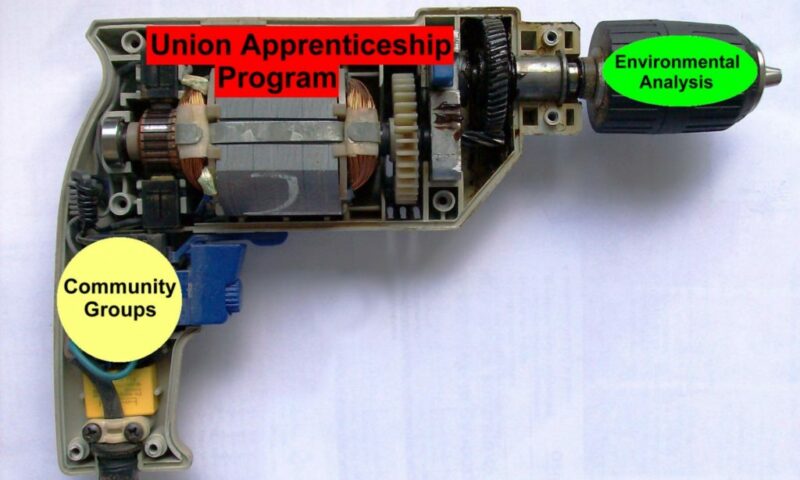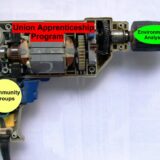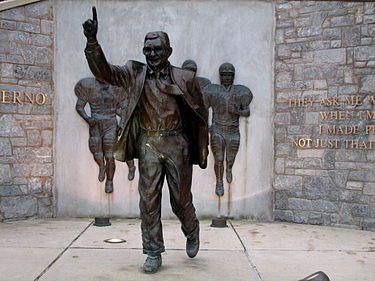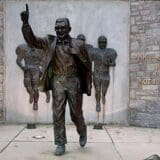

A day laborer falls off an unsafe scaffold and dies. A custodian gets work-related asthma from cleaning products. A painter is tested and found to have lead poisoning. Every year, thousands of California workers are injured on the job or become ill as a result of health hazards at work.
Twelve workers tragically lose their lives on the job each day in the United States, with 409 workplace deaths in California in 2009. Latino workers are particularly at risk. In Los Angeles County, where nearly one quarter of the state’s fatalities occur, Latino workers have a 50 percent higher fatality rate than non-Latino workers.
Work-related injuries and illnesses result in substantial human and economic costs, and can be prevented. Having the data necessary to understand the problem is the first step.
A health indicator is a numerical value or statistic that helps us measure the state of health in a community or group.
» Read more about: Tracking Occupational Health in California »


In the 1960s and ’70s, Saul Alinsky, often considered the founder of community organizing, was a popular figure among liberal activists, based primarily on his how-to manuals, Reveille for Radicals and Rules for Radicals, and his reputation as a tough-talking, street-smart agitator who helped poor and working-class Americans gain a voice in battles with politicians and corporations. Now the Republican Party and its right-wing echo chamber are trying to make Alinsky, who died at 63 in 1972, famous all over again, by linking him to Barack Obama and demonizing the president as a dangerous radical.
During his primary campaign, Newt Gingrich constantly invoked Alinsky’s ghost. “The centerpiece of this campaign, I believe, is American exceptionalism versus the radicalism of Saul Alinsky,” he said in stump speeches and television appearances. Or variously: “If you believe as we do in the Declaration of Independence and you think that’s a better source than Saul Alinsky,
» Read more about: Why Saul Alinsky Is Still Scaring Conservatives »


You don’t have to be a recent homeowner to know how precarious the housing market has been since the bubble popped in 2007. Consider this, for example: Today half of all San Bernardino County homeowners have to put on scuba gear to view their mortgages. Last week, however, just as that county toyed with the idea of seizing such homes through eminent domain, there was a bright spot. Governor Jerry Brown signed into law (to take effect January 1, 2013) the Homeowner Bill of Rights, a consolidation of several bills that had been strongly pushed by state Attorney General Kamala Harris.
The HBR offers several solid benefits to homeowners, but two stick out:
» Read more about: State Gives Struggling Homeowners a "Fighting Shot" »


 Sandra Zebi is no stranger to the challenges posed by urban waste. Now the owner of a vintage clothing store in Marina del Rey, Zebi was born in Sao Paulo, Brazil, which produced 14,000 tons of waste each day.
Sandra Zebi is no stranger to the challenges posed by urban waste. Now the owner of a vintage clothing store in Marina del Rey, Zebi was born in Sao Paulo, Brazil, which produced 14,000 tons of waste each day.
Ironically inspired by her urban surroundings, Zebi created art using recycled materials. Moving to L.A., she renovated a run-down building and now uses it to house her shop, which is filled with recycled clothing and art.
Zebi loves L.A. but she is not a fan of our waste and recycling system. Like many small business owners she has found that her store does not have a recycling option.
Because of her tenacious environmental consciousness, Zebi seeks other options. Some of her actions are illegal or frowned upon by city government. A business partner, Vanessa, for example, gives bags of recyclable materials to neighborhood homeless men who reside near their store.
» Read more about: Out of Stock: Recycling Options for LA Businesses »


The London Olympics starting in two weeks will be an enormous logistical and security challenge for the city. More than four million people are expected to visit London over the Olympic period and billions more will be watching; 4.7 billion people from around the globe watched at least some of the Beijing Olympics in 2008.
Under that kind of global spotlight, successful games will burnish the city’s glow and bring millions of new tourists for years to come. Failure, on the other hand, could tarnish the city’s reputation in the eyes of the world.
London is off to a bad start. The private global security giant, G4S, hired to guard the games failed to meet their hiring targets. The British government has stepped in and called up 3,500 troops to fill in. It’s yet another example of public contracting gone bad.
At first look,
» Read more about: Plan B From Outer Space: Olympics’ Privatization Fiasco »


One central challenge to building a green economy is that for many, the inner workings of a key pillar of that economy — the construction industry — are a mystery. Understanding construction helps us move beyond simply creating green “jobs,” which could be temporary or even dangerous, to building a new green economic sector that generates permanent construction careers.
Construction is one of the largest sectors of the U.S. economy, with a dollar value approaching $800 billion and more than 7.2 million workers. It brings together people from all different walks of life. For community members that the economic downturn has hit the hardest — low-income workers, minorities, women, those returning from the military or from prison — construction offers a chance at a middle-class career.
A growing piece of the construction industry is retrofitting buildings to increase energy efficiency. Launching a project to retrofit a building,
» Read more about: What It Really Takes to Create a Green Economy »


Last week Penn State University released a report by former FBI Director Louis Freeh about the Jerry Sandusky scandal. It confirms what most of us already believed—that the leadership at Penn State had reason to believe Sandusky was molesting children but failed to do anything.
Sandusky’s been convicted, and several key officials—Penn’s president Graham Spanier, athletic director Tim Curley and football coach Joe Paterno —have been fired or have been convicted in the press and will likely soon be convicted in a court. (Paterno died last January.)
Now the debate is turning to the responsibility of the National Collegiate Athletic Association (NCAA), the idea being that the NCAA should impose sanctions on Penn State.
The main idea of this debate is that Penn State’s cover-up says something about the influence of football on a college campus, and on our culture at large. It doesn’t. This isn’t to say the Paterno legend is irrelevant,
» Read more about: The Penn State Scandal: It’s Not About Football »


At any point in their lives, workers may need to take time off to care for either a new child or a sick family member. While we have state and federal laws to protect workers from losing their jobs or benefits when they take leave, the leave time is mostly unpaid. Unpaid leave hurts a family’s income and economic security – many of our working families, especially in this economy, live at the margin and can’t afford to take leave without pay.
No worker should have to make the difficult choice between a paycheck and being there for a loved one.
Ten years ago, labor unions and community organizations in California came together to ensure that our working families did not have to make this difficult choice. We successfully advocated for and passed the California Paid Family Leave (PFL) Act in 2002.
The PFL law established the first-of-its-kind family leave insurance program in the nation.


Economist Robert Reich lays it all out for us as he debunks six conservative economic myths.This clip was taken from a talk at the Summit For a Fair Economy in Minneapolis.


 I just received my my latest 401k quarterly statement and the following was printed on the front. Is this what they mean by “job killing government regulations?” (If so, bring them on!)
I just received my my latest 401k quarterly statement and the following was printed on the front. Is this what they mean by “job killing government regulations?” (If so, bring them on!)
“Beginning August 30, the Department of Labor requires fees to be consistently disclosed to all eligible employees, participants and beneficiaries of retirement plans subject to the Employee Retirement Income Security Act. As a result, statements have been enhanced to display more details about retirement plan fees. Now it may be easier for you to compare fees to overall value. There are no new fees as a result of the new regulations – just new ways of showing fees that already exist.”
Background: The Department of Labor’s Employee Benefits Security Administration (EBSA) released the final rule in February 2012 to give workers uniform, comparable and understandable information about costs and fees of their plan so they can better manage their retirement investments.